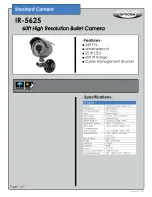
© National Instruments
|
B-1
B
Troubleshooting
This appendix provides instructions for troubleshooting the NI Smart Camera.
Configuration Problems
The NI Smart Camera Does Not Appear in MAX or
Vision Builder AI
Possible causes and solutions:
•
The smart camera may not be powered. Verify that there is power to the smart camera and
that both the smart camera and the development computer are properly connected to the
network. The POWER
LED should be lit green and the ACTIVITY/LINK LED should
flash green when refreshing the list of devices in MAX or Vision Builder AI.
•
The smart camera may have been configured on another network subnet and then moved to
the current network subnet. Reconfigure the smart camera on the current network. Refer to
the
Subnet Considerations
section of Chapter 7,
Ethernet Ports
, for more information.
•
Another device on the network is using the IP address assigned to the smart camera. This
can happen when you assign the same static IP to two devices, you assign a static IP that is
in the range of the IP address available for DHCP use on your network, or the DHCP server
assigns the same IP address to another device. Either remove or reconfigure the other
device, or reconfigure the smart camera to use a different IP address by moving the IP
RESET DIP switch to the ON position and reapplying power or restarting the smart camera.
Refer to the
IP RESET Switch
section of Chapter 6,
LEDs and DIP Switches
, for more
information.
•
You are experiencing firewall issues. If you are having difficulty detecting the system and
setting up the NI Smart Camera on your network, you must configure the firewall to open
the TCP/UDP ports used by the smart camera and the host machine. Refer to the
Firewall
Considerations
section of Chapter 7,
Ethernet Ports
, for more information about TCP/UDP
ports.
•
The cable you are using may be inappropriate for the speed of your network, causing
network communication dropout. While 1,000 Mbps communication over short cables
lengths can be achieved with the CAT5 cable commonly used for 10 and 100 Mbps, CAT5e
and CAT6 cables are more reliable and recommended for 1,000 Mbps links. The smart
camera has the ability to perform auto-crossover, allowing the use of straight or crossover
Ethernet cables, independent of the connection configuration.















































